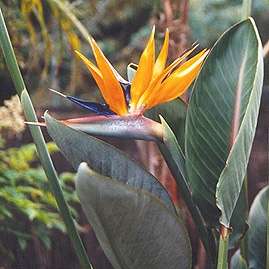September
2002
Did you know that
Strelitzia reginae plant is most well-known as Bird of Paradise
because it has the appearance of a bird's head?
 |
|
Bird of Paradise
(Strelitzia reginae)
|
Bird of Paradise
(Strelitzia reginae)
This must be one of the most well-known plants in the
world. The
fascinating blooms are sold as cut flowers by the million. In Los
Angeles USA, strelitzias are so extensively planted that it is regarded as
the emblem of the city. Strelitzia reginae is, however,
indigenous to South Africa where it grows wild in the eastern Cape of Good
Hope.
The genus Strelitzia was named in honour of
the queen of George III of England - Charlotte of Mecklenburg of
Strelitz in Germany. In 1773, Sir Joseph Banks, then director of Kew
Gardens, named this
exotic "Bird of Paradise" plant Strelitzia
Reginae in honor of his Queen. This South African genus in the family Musaceae
has four species of large perennial herbs with a rhizome or with a
woody trunk. S. alba, S. nicolai, S. reginae var. juncea and
the common S. reginae. Strelitzia reginae is a bold structural
plant, which forms
large evergreen clumps of stiff leaves growing up from the base. The
grey-green banana-like leaves grow about 1,5 m in height and the
flowers stand above the foliage at the tips of long stalks. Mature
plants are very floriferous with flowers in autumn, winter and spring.
The structure and pollination of the flowers are rather
interesting.
The hard, beak-like sheath from which the flower emerges, is called
the spathe. This is placed at right angles to the stem, which gives it
the appearance of a bird's head. The flowers, which emerge one at a
time from the spathe, consist of 3 brilliant orange sepals and 3
bright blue petals. Two of the blue petals are joined together to form
an arrow-like nectary. This plant is
ornithophilous, requiring nectar-eating birds to pollinate its flowers; it is also protandrous
(each
flower's male and female organs are not concurrently receptive to each
other), therefore the pollinating birds are required to transport
pollen from one flower to another. When the birds sit to have a drink of
nectar,
the petals open to cover their feet in pollen. So the birds
transport the pollen to the protruding stigma of the next flower. Fruits develop in the bract and reach the
size of a small hen's egg; when ripe they split into three sections
and reveal up to 80 round, hard, blue-black seeds with bright orange
filamentous arils.
Strelitzia nicolai
(natal) is the tallest Sterlitzia. It grows about
4,5 m in height.
This plant produces white flowers. The name nicolai
is in honour of Czar Nicholas of Russia. It is an important plant for
the
eastern Cape area. Leaf stalks are dried and used to make a rope
for building fish kraals and huts. The immature seeds are edible and
tasty. The flowers provides nectar that attracts sunbirds, especially
Olive Sunbirds and Grey Sunbirds. Vervet and Samango monkeys feed on
the soft part of the flowers as well as on the orange aril of the
seeds. Birds and blue duiker also feed on the flowers. Frogs and ducks
often shelter in the clumps along rivers for protection.
A beautiful yellow form of Strelitzia reginae was selected
recently. This special selection, known as Strelitzia reginae
"Mandela's Gold", has been multiplied at Kirstenbosch where
large plantings can be seen flowering in the winter and spring.
Source:
http://www.plantzafrica.com/plantqrs/strelitziareginae.htm
http://virtual.clemson.edu/groups/bcd/strelitz.htm
http://www.plantzafrica.com/plantqrs/strelitznichol.htm
|
